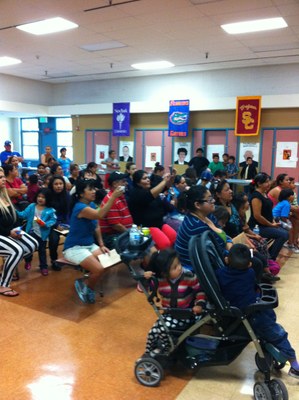Grade-Level Chair
Overview
As grade-level chair it was important for me to know what the district and my principal’s priorities were for my grade-level, these focused on the Common Core State Standards. In English Language Arts, this included helping students to be able to develop an argument using evidence, and to be able to defend their argument. Students also had to be able to conduct research, prepare and present their findings publicly, and to be able to answer questions about their topic.

My grade-level colleague and I realized this would mean a shift in our current classroom practices. The first half of the year our grade-level meetings focused on English Language Arts and incorporating Project Based Learning into our classroom instruction. We felt this was one way we could immediately begin to help students access what the CCSS were asking them to do. Our first public presentation of culminating projects was such a success we decided to make an evening of it, and it became one of my leadership activities.
The second half of the year our grade-level meetings focused on the Common Core Math Practices, specifically Math Practices 1 and 3, where students are asked to be able to explain their mathematical reasoning, to defend it, and to be able to critique the reasoning of others. Again, our classroom instruction had to shift and change. I researched a strategy that would help English Language learners access what the CCSS were asking them to do. This became the basis for my leadership project, and the focus of our grade-level meetings for the second half of the year.
 Responsibilities
Responsibilities
- I facilitated grade-level meetings.
- I disaggregated and shared data with my colleagues to guide and lead our planning and instruction. This was essential because early in the year we incorporated improvement cycles into our classroom practice, analyzing data and acting upon it were important components of these cycles.
- I met regularly with my principal to discuss any new curriculum and instruction issues. For example, late in the year we were asked to substitute an entire unit my colleague and I had already planned for to implement a unit the District had prepared for 5th grade. This re-directed the focus of our final grade-level meetings.
- Report directly to the principal any requests or concerns my grade level may have. There were several issues and concerns that came up throughout the year. These became valuable learning experiences for myself as a future school leader.
Reflection
As a result of our planning and in collaboration with our principal we were able to plan for two major events where we invited our parents to evening school functions where their children were given an opportunity to stand in front of an audience, some for the first time, and present research they had done. Their final presentations included everything from tri-fold poster boards, to paintings, to dioramas, to murals, to a couple of plays, and even a monologue.

At our grade-level meetings we analyzed data to inform changes to our teaching practices. We changed templates, lesson structures, our methodology, and even our schedules to help improve student scores on classroom and district assessments. We constantly assessed to see how changes were impacting our students’ scores.
We also used data to tailor our instruction to meet the individual needs' of our students. Data helped us identify which children might need small group and/or one-on-one help with our T.A. As a result, I feel more comfortable using data to inform my instruction.
Because of our grade-level planning, the scores of all our students, especially in the area of math, a district focus for our school, improved significantly. I felt my colleague and I effectively planned to meet the needs of all our students to provide them access to a high quality education.
Connection to CPSELs
- CPSEL #1 - Through the various evening functions with parents we shared with them the districts vision for helping all students be college and career ready by the time they leave our public school system, via the Common Core State Standards. We used data to inform our teaching practices and to make changes where necessary to help students access the learning going on.
- CPSEL #2 – As grade-level chair I helped promote equity, fairness, and respect among the members of the school community. I provided opportunities for all members of the school community to develop and use skills in collaboration, I distributed leadership, and I shared responsibility. Professional Development was used as an opportunity to address the immediate needs of the school community. I provided staff with tools to work more effectively with one another to improve student learning.
- CPSEL #3 – In planning out the evenings for the parents we had to make sure we maintained a safe, efficient, clean, well-maintained, and productive school environment for the parents and students to enjoy. We established school structures and processes that supported student learning.
- CPSEL #4 - We collaborated with the families and community and responded to their diverse interests and needs through various presentations put on by the students. We put on a Latin-American Festival. We featured famous historical figures of color and their struggles, and tied that knowledge back to our community.
- CPSEL #5 - In working with my colleagues to plan out the various events we put on for the school and parents, and through the PBL curriculum we began focusing on this year, I feel I helped my colleagues grow as educators. My 5th grade colleague led grade-level meetings we facilitated with 4th grade and the SDC teachers.

